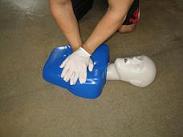Differences between adult and pediatric CPR

When you give CPR to children, especially infants and toddlers, the techniques and principles behind the skills are very different compared to CPR given to adults. One of the main differences is the primary cause of cardiac arrest. Arrest in adults is typically cardiovascular in nature, most commonly due to heart disease or predisposition to a stroke or MI (myocardial infarction). In children, especially infants, cardiac arrest is primarily respiratory in nature – typically termed asphyxial arrest.
When it comes to management, the basics are the same, but a lot more emphasis is placed on ventilation when you rescue children. Especially when rescue breaths are given, it is ideal that a child’s airway is clear and the breaths that are given are effective and adequate. The placement of the bag valve mask or the use of an endotracheal tube is very important to ensure that the child is receiving adequate oxygen.
PALS training
All six of our training providers in the country offer students a chance to study Pediatric Advanced Life Support (PALS). PALS is categorized under Advanced Life Support training, courses where students are taught how to give medical management to victims. Medical management covers the use of medication and equipment.
PALS is a two-day course, lasting 14 hours long. It covers the following topics:
- One and two-person CPR (infants and toddlers)
- Rescue breaths with bag valve masks
- ECG procedure and reading
- Medication – pediatric dosing, administration
- Basic first aid for common injuries
PALS renewal / re-certification
Re-certification is also available for PALS training. It can run for either 6 hours and 20 minutes or 8 hours and 20 minutes, depending on the stations that the trainee takes. Re-certification is used to renew nearly expired certification NOT expired certificates. We do not renew certificates that have expired, only those approaching expiration.
If your credentials have expired, you will have to take the training program again, instead of the shorter re-certification class.
Certificates
PALS training certificates are renewed every 24 months (2 years). Depending on where you live, your state will require you to update your training every number of years, usually every year, or simply take re-certification before the expiration of your credentials.
Enrolment
We have locations in six cities in the US. These cities are Los Angeles (California), San Francisco (California), Las Vegas (Nevada), Honolulu (Hawaii), Seattle (Washington), and Portland (Oregon). Add the word “CPR” to each city name and you’ll have the name of our training provider.
All of our providers have their own respective websites; visit them and you can fill out the online application form to enrol for any of our classes, either BLS (Basic Life Support) or Advanced Life Support (ALS). You can also find our contact details on the websites, so if you decide to send us an e-mail or give us a call you can. We encourage our prospective trainees to enrol in person as well, but be sure to do so during business hours only.
